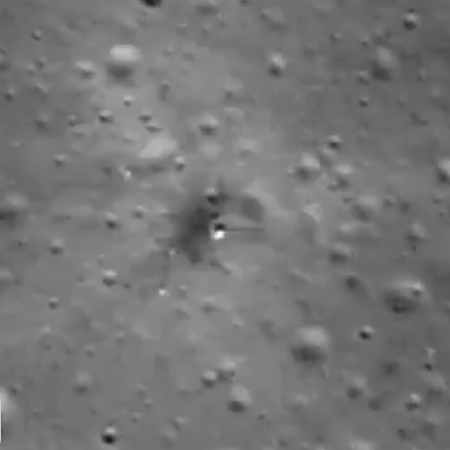Two lunar orbiters spot the crash site of Ispace’s Resilience lander

Scientists using both NASA’s Lunar Reconnaissance Orbiter (LRO) and India’s Chandrayaan-2 lunar orbiter have spotted the crash site for the private commercial lunar lander Resilience, built and launched by the Japanese startup Ispace.
The picture to the right was taken by Chandrayaan-2. As noted at the LRO website showing its photo:
The dark smudge (60.4445°N, 355.4120°E, -2431.6 m elevation ) formed as the vehicle excavated and redistributed shallow regolith (soil); the faint bright halo resulted from low-angle regolith particles scouring the delicate surface.
The lander attempted a soft landing on June 5, 2025, but because its laser rangefinder was unable to gather good data as to its elevation, it did not decelerate properly and was going too fast when its engines tried for a soft landing. It instead crashed.
On Christmas Eve 1968 three Americans became the first humans to visit another world. What they did to celebrate was unexpected and profound, and will be remembered throughout all human history. Genesis: the Story of Apollo 8, Robert Zimmerman's classic history of humanity's first journey to another world, tells that story, and it is now available as both an ebook and an audiobook, both with a foreword by Valerie Anders and a new introduction by Robert Zimmerman.
The print edition can be purchased at Amazon or from any other book seller. If you want an autographed copy the price is $60 for the hardback and $45 for the paperback, plus $8 shipping for each. Go here for purchasing details. The ebook is available everywhere for $5.99 (before discount) at amazon, or direct from my ebook publisher, ebookit. If you buy it from ebookit you don't support the big tech companies and the author gets a bigger cut much sooner.
The audiobook is also available at all these vendors, and is also free with a 30-day trial membership to Audible.
"Not simply about one mission, [Genesis] is also the history of America's quest for the moon... Zimmerman has done a masterful job of tying disparate events together into a solid account of one of America's greatest human triumphs."--San Antonio Express-News

Scientists using both NASA’s Lunar Reconnaissance Orbiter (LRO) and India’s Chandrayaan-2 lunar orbiter have spotted the crash site for the private commercial lunar lander Resilience, built and launched by the Japanese startup Ispace.
The picture to the right was taken by Chandrayaan-2. As noted at the LRO website showing its photo:
The dark smudge (60.4445°N, 355.4120°E, -2431.6 m elevation ) formed as the vehicle excavated and redistributed shallow regolith (soil); the faint bright halo resulted from low-angle regolith particles scouring the delicate surface.
The lander attempted a soft landing on June 5, 2025, but because its laser rangefinder was unable to gather good data as to its elevation, it did not decelerate properly and was going too fast when its engines tried for a soft landing. It instead crashed.
On Christmas Eve 1968 three Americans became the first humans to visit another world. What they did to celebrate was unexpected and profound, and will be remembered throughout all human history. Genesis: the Story of Apollo 8, Robert Zimmerman's classic history of humanity's first journey to another world, tells that story, and it is now available as both an ebook and an audiobook, both with a foreword by Valerie Anders and a new introduction by Robert Zimmerman.
The print edition can be purchased at Amazon or from any other book seller. If you want an autographed copy the price is $60 for the hardback and $45 for the paperback, plus $8 shipping for each. Go here for purchasing details. The ebook is available everywhere for $5.99 (before discount) at amazon, or direct from my ebook publisher, ebookit. If you buy it from ebookit you don't support the big tech companies and the author gets a bigger cut much sooner.
The audiobook is also available at all these vendors, and is also free with a 30-day trial membership to Audible.
"Not simply about one mission, [Genesis] is also the history of America's quest for the moon... Zimmerman has done a masterful job of tying disparate events together into a solid account of one of America's greatest human triumphs."--San Antonio Express-News


Lunar orbiters – Have any lunar orbiters ever been able to get an image of a passing object? When Apophis approaches in 2029, will any lunar orbiters try to get an image? I realize that the Ramses probe will rendezvous with Apophis. An image of Ramses with Apophis from a lunar orbiter would be…well…… Cool Image Time!
Ronaldus Magnus: Do a search on BtB for “Apophis”. It will bring up all the information on all the missions in the works to get to the asteroid in 2029. None are from the lunar lander companies, as they aren’t yet advanced enough to do it.
Your question though makes me wonder if the lunar orbiters might be able to grab an image. Likely not, as the speeds will be too great, but the question is worth asking.
I’d settle for just getting some new and more capable lunar orbiters into lunar orbit. The ones we’ve got now have done yeoman work, but they’re also getting pretty long in the tooth and nothing lasts forever.
Re: snapshots of Apophis in 2029, I would think something in GEO would get you a more interesting shot – and from much closer – than could any extant or notional new lunar orbiter.
Dick Eagleson wrote: “I would think something in GEO would get you a more interesting shot – and from much closer – than could any extant or notional new lunar orbiter”
Geostationary weather satellites might have the cameras in interesting wavelengths, but can they be pointed in the right direction and can they keep up with the motion of the asteroid? We seem to have an opportunity for some close-up science.